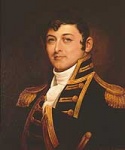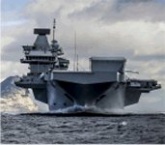-
 On this day 8 September - the French and British engage in the Indian Ocean
On this day 8 September - the French and British engage in the Indian Ocean
The Action of 8 September 1796 took place in the Indian Ocean, when a French frigate squadron under contre-amiral Pierre César Charles de Sercey encountered two British 74-gun ships of the line. Under orders to avoid doubtful encounters, Sercey retreated and the British gave chase. In the ensuing gunnery exchange, the British ships sustained enough damage to be forced to retreat, and the French squadron continued its cruise unhindered.
On 4 March 1796, a frigate squadron under contre-amiral Sercey left Rochefort for Mauritius. Its mission was to deliver 800 soldiers and two artillery companies, under general François-Louis Magallon, large quantities of food and ammunitions, and two Directory commissioners: Baco and Burnel. Once the squadron had completed its primary mission, the squadron's secondary mission was to disrupt British trade in the Indian Ocean. The squadron comprised Vertu (Lhermitte), Régénérée (Willaumez), Forte (Beaulieu-Leloup) and Seine (Latour and later Bigot). The corvettes Bonne Citoyenne and Mutine reinforced the squadron until they had to return to Rochefort after sustaining damage in a storm in the Bay of Biscay. The four frigates reached Mauritius in 18 June after taking a number of prizes en route. Soon after his arrival, Sercey had two more frigates readied to reinforce his squadron. These were Prudente (Magon) and Cybèle (Tréhouart). He also requisitioned a privateer cutter, Alerte, and brought her into service to replace his missing corvettes. On 14 July, the division set sail to raid British commerce. Because Alerte sailed badly, retarding the squadron, Sercy detached Alerte, sending her to the Dutch neutral post of Tharangambadi to locate the British squadron. Unfortunately, on 19 August she mistakenly attacked HMS Carysfort (James Alexander), which Alerte had taken for a merchantman; Carysfort captured her.
On 8 September 1796 as the division cruised off Sumatra, they spotted two sails, which they soon recognised to be British 74-guns. As Sercey's orders were to avoid any engagement of unclear outcome, he decided to break contact. Seeing the squadron retreating, the British ships of the line, HMS Victorious (Captain William Clark) and HMS Arrogant (Captain Richard Lucas), gave chase. The British caught up with the French on 9 September at dawn, which the Admiralty, which counted the day as running from noon to noon, still counted as 8 September. Around 7:00a.m., the lead British ship opened fire on Vertu, which had the rear of the French squadron. Vertu closed to Seine for support, and Sercey sent signals for a general engagement. Vertu sustained most of the British fire, but Sercey then ordered his frigates to engaged the British at point blank range, causing a fire aboard one of the ships. During the action, Tréhouart ordered a boat launched to tug the becalmed Cybèle into a position where she could rake Victorious. As her crew was occupied controlling the fire, the French turned their guns against the second ship, which had to retreat.
Having lost none of his warships, Sercey remained free to roam the Indian Ocean, which he continued to do for another two years.
Pierre César Charles de Sercey:

Today's event is taken directly from http://en.wikipedia.org/wiki/Action_of_8_September_1796
-

Six French frigates versus two British 3rd rates.
Contre-amiral de Sercey took his chance (maby not that voluntary  ) and defeat them.
) and defeat them.
The French had good frigates.
-

If there had been more outcomes like this one I wonder what the global power structure would have looked like in the 19th century? 
-

Another interesting example of ships of the line out-sailing frigates and bringing them to action. A rare occurrence, but obviously not entirely unknown and worth bearing in mind when putting hypothetical scenarios together.
-

That's a point I wonder about too, David.
Normally they shouldn't be able to catch the frigates. 
Anyways, the portion they try to swallow was to big.
-

Was there a heavy swell giving the heavier ships an advantage?
 Posting Permissions
Posting Permissions
- You may not post new threads
- You may not post replies
- You may not post attachments
- You may not edit your posts
-
Forum Rules






 Reply With Quote
Reply With Quote

 ) and defeat them.
) and defeat them.





Bookmarks